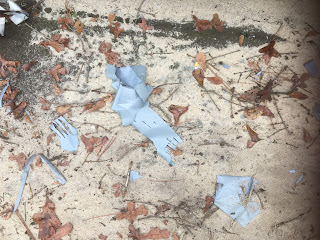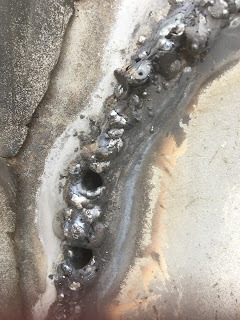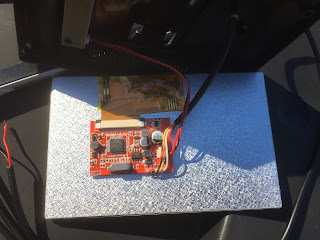As a school bus driver in my normal role, it horrifies me that so many people drive school bus conversions without the foggiest idea of what they are doing. Worse than that, most think and believe they know what they are doing despite never having driven a bus before in their entire lives.
I'll start with mirrors. There should be three mirrors per side - minimum. I have seen and driven busses with fewer but it does increase blind spots. These are the mirrors I have on my own personal bus conversion. The top mirror shows me what's in the lane next to the lane beside me and anything coming. This helps avoid accidents from two vehicles trying to merge into the same lane at the same time. It also helps when joining onto a road via a Y junction when approaching traffic is behind and to the left (or right).
The middle mirror is there to show clearly what's in the lane behind the bus, bearing in mind the mirrors will not show what's directly behind you. There is a cone of invisibility that reaches about 200 feet in which cars, trucks and motorbikes can't be seen. A rearview camera supplements mirrors but does not and cannot replace them. Electronics are zero percent reliable in critical situations.
The bottom mirror shows you what's beside the bus and should show the back wheel and everything up to the driver's window. Seeing the back wheel is very important for cornering. More on that later.
The crossview mirror is there to show primarily anything directly in front of the bus or the bus wheels. It also helps with lane placement. As a professional of 4 years standing, I do use the crossview mirror to check my lane positioning, particularly when I'm passing another big vehicle on the other side of the road. Mirrors colliding produce debris and damage with possible fatal consequences. This is a half mirror. A full elpitical mirror will show the roof line which may be helpful when trying to get under lower bridges.
Heated mirrors are preferable to unheated. My bus was designed without heated mirrors and though I could put a mirror heater timer switch in, it's not something that I will be doing. Motorized mirrors are in my opinion a waste of time unless you have an issue with leaping out of the bus to adjust the mirrors and back in to check them. It's how I adjusted these and it did take some time. For multiple drivers using the same bus, it's essential.
I won't go on about the driver's seat suffice to say air seats are very nice. My work bus has one and I can adjust it in a trice. My own has a manually adjustable seat which took quite some adjusting. In fact I had to use a wrench to lower it to the correct height, proving that for the entire time that bus had been in use, the seat had always been set too high.
The ideal position for a seat and steering wheel is with the legs as straight as possible without straining to touch the top of the steering wheel with your hands. Prolonged driving with poor seat positioning results in sore knees and potential loss of control.
Before going on a trip there's a lot of checking that must be done. I don't mean should be done, out to be done. I do mean must be done. This is not just because these busses are old and things can and do fail at the drop of a hat but for safety sake. It's illegal to drive with defective tires or lights. Simply looking at a tire won't tell you if it's bad.
The first think to do is to get all the lights on and walk around to make sure they're all working. Stop and replace bulbs or fuses for the lights that are not working. Next, check the tires. These can be checked with a billy club or a pressure gauge. The inside tire on the back duals needs to be checked too. If it's flat it will look fine but when you put your hand on it and give it a push, it will feel loose.
Next, check the glass is clean and clear - free of stickers or anything that impedes vision. Check the mirrors for being clean and correctly angled. None of the lights, glass or mirrors must be cracked, broken, missing, chipped or the wrong color.
Check the front hub seals and back axle seals for leaks. Check all the lug nuts for tightness. Loose lug nuts will show shiny metal or will have a rust band.
Before moving the bus, keep the parking brake on, put the bus in gear and depress the accelerator slightly. The bus should not move. If it does, stop as there's a problem with the brakes.
Check underneath for drips of oil, drips of fuel, drips of coolant. Dip the oil, transmission fluid and check the power steering fluid and radiator coolant. Check all belts and hoses for cracks, fraying (leaks on the hoses) and their presence. If you have DEF, check that too.
Roll underneath and check brake lines. Check the steering linkages and the brakes. You might have air brakes or hydraulic brakes. Know which you have a check accordingly. Check the steering - there should be less than an inch of slop in the wheel.
Remember you are driving a 16 ton missile that can kill dozens of people, not just a whoopsie that dents another car and puts you in debt to the insurance company. A bus will ride up on top of a car and crush it underneath. This is why you need to make sure everything is as perfect as possible. You need to be able to prove you did your bit responsibly in order to diminish liability.
For driving, be aware of four things. Weight, height, width and length. Many bridges might have a height or weight limit. If your bus is close to the height limit, be careful as that height limit might not have been remeasured after the road was last resurfaced. Weight limits need no explanation - an overweight vehicle could collapse through the road surface even if it passed over a hundred times before. Remember your vehicle is wide and you need to allow clearance on many roads when approaching other big vehicles. The key is to move over to the curb side as much as possible without hitting the curb or any mailboxes. If in doubt, stop. Length might seem daunting but all it is, is a case of waiting to turn the steering wheel until the back wheel is at the corner (not just before or just after). You will need to borrow from the other lane of the road you are turning into. Do not borrow from the lane beside you. Getting close to the line beside you without getting into the other lane can help a lot.
In normal driving, remember you are driving an old school bus. It will not be the fastest vehicle on the road. It is not a Ferrari nor is it a Mercedes. It is not a Lamborghini either. Your normal driving should be in the outside lane so everybody can pass you safely. Remember schoolbusses are designed to spent 90% of their lives on narrow, rural roads, not on interstates. They are designed to traverse dirt tracks rather than interstates.
It may be possible to raise the speed of your bus to greater than 55mph. Please resist the urge to do so. It is not good for the engine or the transmission, despite what somebody else may have written online. When traversing dirt tracks, keep your speed down to 15mph or less - things can vibrate and fall off or break off. It has happened. In fact the battery door latch broke off when I was doing 10mph on one dirt track.
Remember to leave plenty braking distance and to be alert for idiots overtaking or emerging unexpectedly from side roads. One idiot pulled out in front of my work bus a few days ago. The ABS on the work bus failed when I braked (I've never known ABS not to fail when needed) so I left a 20 foot skidmark but avoided hitting him. I was doing the speed limit. Remember if you have a crash that if you have your ducks all lined up by doing what you should be doing then you're unlikely to be spending time as the jail's latest sex slave.
If you have anger issues then driving a schoolbus might not be for you. Remember to check your mirrors at least every 7 seconds. Definitely check both sides if there is traffic on both sides of you.












































